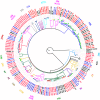Composite mobile genetic elements disseminating macrolide resistance in Streptococcus pneumoniae
- PMID: 25709602
- PMCID: PMC4321634
- DOI: 10.3389/fmicb.2015.00026
Composite mobile genetic elements disseminating macrolide resistance in Streptococcus pneumoniae
Abstract
Macrolide resistance in Streptococcus pneumoniae emerged in the U.S. and globally during the early 1990's. The RNA methylase encoded by erm(B) and the macrolide efflux genes mef(E) and mel were identified as the resistance determining factors. These genes are disseminated in the pneumococcus on mobile, often chimeric elements consisting of multiple smaller elements. To better understand the variety of elements encoding macrolide resistance and how they have evolved in the pre- and post-conjugate vaccine eras, the genomes of 121 invasive and ten carriage isolates from Atlanta from 1994 to 2011 were analyzed for mobile elements involved in the dissemination of macrolide resistance. The isolates were selected to provide broad coverage of the genetic variability of antibiotic resistant pneumococci and included 100 invasive isolates resistant to macrolides. Tn916-like elements carrying mef(E) and mel on the Macrolide Genetic Assembly (Mega) and erm(B) on the erm(B) element and Tn917 were integrated into the pneumococcal chromosome backbone and into larger Tn5253-like composite elements. The results reported here include identification of novel insertion sites for Mega and characterization of the insertion sites of Tn916-like elements in the pneumococcal chromosome and in larger composite elements. The data indicate that integration of elements by conjugation was infrequent compared to recombination. Thus, it appears that conjugative mobile elements allow the pneumococcus to acquire DNA from distantly related bacteria, but once integrated into a pneumococcal genome, transformation and recombination is the primary mechanism for transmission of novel DNA throughout the pneumococcal population.
Keywords: Streptococcus pneumoniae; antibiotic resistance; integrative and conjugative elements; macrolides; mobile genetic elements; transposons.
Figures






References
Grants and funding
LinkOut - more resources
Full Text Sources
Other Literature Sources

